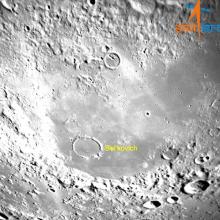Listen to today's episode of StarDate on the web the same day it airs in high-quality streaming audio without any extra ads or announcements. Choose a $8 one-month pass, or listen every day for a year for just $30.
You are here
Moon and Companions
A beautiful triangle will greet early risers tomorrow: the Moon, the planet Venus, and the star Spica. They’re in good view as the first blush of twilight paints the sky.
The Moon is a waning crescent right now. The “crescent” part is pretty obvious — sunlight illuminates only a sliver of the lunar hemisphere that faces our way.
It’s nighttime across the remainder of the lunar disk. It’s not an especially dark night, though, because the gibbous Earth hangs in the sky. Earth is bigger than the Moon is, and its surface reflects more sunlight. So a gibbous Earth provides many times more light than the full Moon offers here on Earth. And you can see the “earthshine” for yourself — it gives the dark portion of the lunar disk a ghostly appearance.
The Moon is “waning,” which means the bright crescent is getting smaller by the day. The Moon will disappear in the dawn twilight in a few days. And it’ll pass between Earth and Sun on Thursday night, when it’ll be “new.” It’ll then return to view a couple of nights later — this time in the evening sky, as a waxing crescent.
For now, look for the beautiful Moon before and during dawn. Venus, the brilliant “morning star,” will stand almost directly below the Moon tomorrow. And Spica, the leading light of the constellation Virgo, will stand a little farther to the lower right of the Moon. Venus and Spica will line up to the upper right of the Moon on Tuesday.
Script by Damond Benningfield






